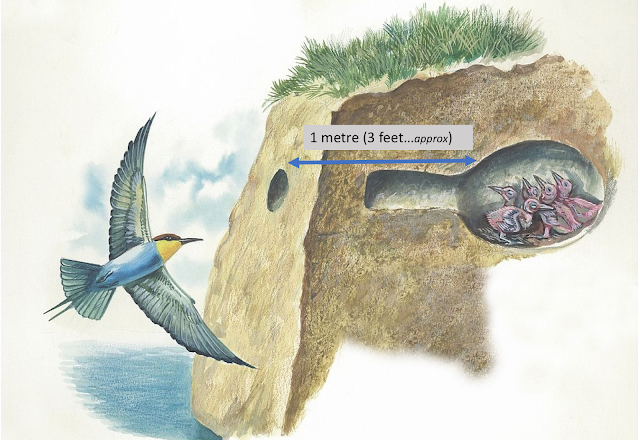Chestnut-headed Bee-eaters turning religious (part two)
On a bushy hillside on Penang island is a large religious complex called Kek Lok Si Buddhist temple. It is a major tourist attraction and a target for worshippers of that faith. During Chinese New Year celebrations a colourful bird species adds to the decorations. Chestnut-headed Bee-eaters have adopted the complex during their breeding season. Early in the breeding season pairs of bee-eaters can be observed catching insects and investigating potential nesting holes.
 |
| The Kek Lok Si temple complex |
 |
| A tourist attraction after lights are switched on |
Chinese Lanterns and Bee-eaters
There are many silent witnesses to this activity.
Being on a hillside extensive retaining walls are required. These consist of a concrete exterior holding back the soil of the hill. Drainage or weep holes are necessary to drain the soil and these are lined up in a regular pattern. Most of the drainage holes which are dry, are lined with a PVC pipe, which is about a metre in length ending in the dirt interior. The dimensions are such that if a nursery chamber is added, the inside the dimensions to the previously described bee-eater nests at Penanti are very similar.
 |
| ......compared with the nests at Penanti. |
This observation has not escaped the attention of this smart bird species. There is plenty of evidence that nursery chambers are being excavated. The only problem seems to be competition with Crested Mynahs, who also nest in man-made cavities.
 |
| Checking out the housing options |
 |
| The nursery chamber is being evacuated |
 |
| The dirt is kicked out the front door |
The whole scene is reminiscent of other species of bee-eaters nesting in colonies in clay cliffs in holes that have been excavated years before. There are several species of Carmine Bee-eaters that do this in Africa. In this temple colony most of the energy needed for excavation can be put towards hunting in the mixed forest and hillside farm in the vicinity. Insects are plentiful there.
 |
| African bee-eaters nesting in colonies on a clay cliff |
Over the next few month there is a flurry of feeding activity as the road adjacent to the wall is crisscrossed many times by colourful streaks as insects are delivered to hungry chicks
 |
| There is a good supply of insects in the vicinity |
 |
| A sequential action series of a feeding |
Like the nesting in the countryside the mature chicks can be seen at the pipe entrance as fledging approaches. This appears to be more of a problem due to the rigidity of the concrete and plastic. The chick is essentially blocking the feeding for its siblings. The parents are not ignorant of this problem and they first try persuasion. Flying close to the chick they silently implore it to fly off and fledge thus relieving the blockade.
Like most doting parents patience has its limits. Next comes the uncorking.
An adult will fly in as normal with an insect in its bill. The hungry chick makes a grab for the morsel but the adult's bill clamps down firmly on that of the offspring. It then lunges backwards drawing out the recalcitrant chick. It has now fledged.
 |
| A parent arrives with an insect for the chick at the entrance |
 |
| The chick is extracted from the nest ............ |
 |
| ........and has fledged |
I expect over the following years the colony nesting will get more popular. There appears to be fewer problems; no feral dogs, out of reach of poachers, fewer parasites, less interest from photographers and only distant motorbikes. There is only competition from Crested Mynahs and the odd threat from passing raptors. There is always better security with many eyes looking.
There are no signs that other bee-eaters are pursuing a similar strategy. Both blue-throated and Blue-tailed bee-eaters are reported to nest in Penang state. Both are migrant nesters and are larger than the Chestnut-headed. They also have the elongated tail-feathers at may make pipe traversing less comfortable.























Comments
Post a Comment